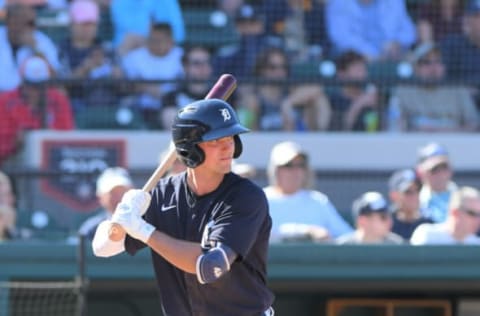Detroit Tigers minor-league tools series: Best Hitter

Taking advantage of MLB gridlock to look at the Detroit Tigers farm system.
MLB owners have locked out the players, so Detroit Tigers news figures to be a bit scarce for the next few weeks. But that lull gives us a chance to look to the minor leagues and hopefully give readers a better idea of the skills displayed by players in Detroit’s farm system.
This is the first of a dozen articles about the best individual player tools in the Detroit Tigers farm system. If you want to refer to this series as “The 12 Tools of Christmas” we won’t stop you.
Fans who found their Detroit Tigers minor-league coverage at TigsTown will be familiar with this format. We describe what we’re looking for in each tool, then list the five best examples in the Detroit Tigers system, along with a few honorable mentions, and young prospects who may climb the list soon. Let’s begin.
Detroit Tigers Minor League Tools Series: Best Hitter
When we talk about the hit tool we’re generally looking for three skills:
- The ability to put the bat on the ball
- The ability to hit the ball with authority
- The ability to control the strike zone
The best hitters combine all three skills, and players generally need two of these skills to be successful big-league hitters. At the risk of sounding like Yogi Berra…it’s hard to be a good hitter if you can’t hit good. Putting bat to the ball is essential, but without power and/or patience, that contact can become something of a Pyrrhic victory.
In the player profiles, we’ll touch on other factors that play into the utility of the above skills — the ability to adjust, bat speed, and pitch recognition — but let’s make with the lists.
Detroit Tigers Best Hit Tools: Future Shock
- Cristian Santana – IF
- Iverson Leonardo – OF
- Danuerys De La Cruz – C
- Carlos Mendoza – IF
Detroit Tigers prospect hounds likely recognize the name Cristian Santana, as he was the club’s top signing for the 2020 class international free agent class, and he already ranks among the team’s top-10 prospects at FanGraphs and MLB Pipeline. Santana also had a terrific pro debut, batting .269/.421/.520 with 9 home runs, good for a 161 wRC+ in the Dominican Summer League (DSL). Judging players based on rookie-league stats is unwise, but the combination of Santana’s production and prospect pedigree make him a player worth watching.
Iverson Leonardo, Danuerys De La Cruz, and Carlos Mendoza weren’t as highly regarded as Santana as amateurs, but they’ve each shown positive signs in pro ball. Leonardo had a strong 2019 season in the DSL, and while his batting average dipped to just .229 in his U.S. debut this year, his patience and power kept led to a very productive season in the Florida Complex League (FCL). De La Cruz ended up leading the FCL with a .283/.432/.543 line this season, while Mendoza is an undersized slap hitter with a strong eye and good contact skills.
Detroit Tigers Best Hit Tools: Honorable Mention

Andre Lipcius – IF
Lipcius hit just .238/.312/.378 over 94 games at Double-A Erie last year, so those who scout the stat line might wonder why he’s on the list. He may ultimately lack the bat speed to catch up to premium velocity and be anything more than a fringe-average hitter, but everything else about his process at the plate is sound. He consistently puts together quality plate appearances, makes two-strike adjustments, sprays the ball from gap to gap, and has enough power to punish mistakes.
#Tigers prospect Andre Lipcius had a ton of long at-bats last night and showed soft hands at third base pic.twitter.com/FPnbJBxRAd
— Jake Boes (@BoesKnowsBB) June 11, 2021
Austin Murr – 1B/OF
Austin Murr was Detroit’s 6th-round pick in the 2021 draft, and though he was considered something of a value senior sign, it didn’t take long for him to put some impressive offensive skills on display. Murr finished the season with a .319/.440/.393 line over 39 games, and he was an absolute pest in the batter’s box, putting together marathon at-bats, refusing to expand the zone, and hitting the ball from line to line — at one point in West Michigan he had a 16-game hitting streak. Murr didn’t hit the ball particularly hard, though, and he’ll need to get his legs more involved in his swing to produce the kind of power necessary to succeed at higher levels.
Austin Murr came into tonight with a 14-game hitting streak, but back in the 5th he gave himself up to get two runners in scoring position. In the 7th he put himself into scoring position with a hustle double and extended that streak. @ThatDanHasty on the call. pic.twitter.com/V6terUHVBp
— Tigers Minor League Report (@tigersMLreport) September 9, 2021
Detroit Tigers Best Hit Tools: Numbers 5 and 4

5 – Eliezer Alfonzo – C
Elizer Alfonzo is one of the more fascinating players in Detroit’s system. He has hung around the fringes of prospectdom for a few seasons, but it’s easy to miss what he does well and focus on his deficiencies. He’s a well below-average defender behind the plate — though he did improve over the course of 2021 — and for most of his career he has shown zero in-game power. But the switch-hitting Alfonzo is a contact savant.
He’s a career .304 hitter in the minors, with contact rates hovering around 83%, and career walk and strikeout rates in the single digits. And Alfonzo may have unlocked a bit of power late in the season, responding to a mid-season demotion to Lakeland by mashing 15 extra-base hits in 39 games, and then slugging .487 over 21 games in a return to High-A West Michigan.
Eliezer Alfonzo hit .355 over his final 21 games after returning from Lakeland.
— West Michigan Whitecaps (@wmwhitecaps) September 20, 2021
The 21-year-old hit seven home runs in with the @LkdFlyingTigers in just 39 games, but hadn't yet hit one for us.
He had one last chance in the 9th inning on Sunday.
🎙️ @ThatDanHasty pic.twitter.com/V51eRmJlsE
4 – Colt Keith – 3B/2B
When the Detroit Tigers selected and signed Colt Keith in the 5th round of the 2020 draft (132nd overall) it was very much a pleasant surprise, because Keith was generally considered a 2nd round talent. He couldn’t play pro ball in 2020, of course, and was held back in extended spring training for about a month last season. It took him a few weeks to get adjusted to Low-A, but then he took off, batting .379/.493/.508 in a 35-game stretch from July 1st to August 22.
Keith struggled for 18 games after being promoted to High-A West Michigan, but he remains one of the most exciting young hitters in the system. He’s aggressive at the plate, but generally stays in the zone and will take plenty of walks, and his short, quick swing is geared for hard line drives. He only hit two home runs in 65 games, but that’s more a function of his launch angle than his raw power — his max exit velocity last year was 109.8 MPH. So even if he doesn’t clear the fence more often, he has more enough sock to pose a threat to pitchers.
Colt Keith with a pair of hard hits off a lefty tonight. pic.twitter.com/GqLuDNxl4q
— Tigers Minor League Report (@tigersMLreport) September 2, 2021
Detroit Tigers Best Hit Tools: Numbers 3 and 2

3 – Ryan Kreidler – SS/3B
If not for the two generational prospects above him on this list, Ryan Kreidler probably would have been the story of the Tigers minor leagues in 2021. He came into the season as something of an afterthought, but turned himself into a top-10 prospect in the system after batting .270 with 22 home runs between Double-A and Triple-A.
Kreidler had some strikeout issues to begin the year, and he still has some issues identifying breaking balls and swinging at high heat, but his plate discipline improved dramatically over the course of the season:
There are times when his short, direct swing almost looks like an emergency hack (it’s vaguely reminiscent of that of former Detroit Tigers utility man Don Kelly) but Kreidler packs a surprising amount of punch, and can drive the ball in any direction. He talked about his approach and swing in this recent article at FanGraphs.
Ryan Kreidler goes deep for the 2nd night in a row, this one to right-center. It’s his 17th homer of the season, and he’s 3-for-4 tonight with a double, a homer, and 3RBI. 👀👀👀 pic.twitter.com/vSY1ry9vnG
— Tigers Minor League Report (@tigersMLreport) August 19, 2021
2 – Spencer Torkelson – 1B/3B
The Detroit Tigers made Spencer Torkelson the top overall pick in the 2020 draft, and he lived up to that lofty honor in his first year of pro ball. He hit his way out of High-A West Michigan in fewer than six weeks, blasted through Double-A in two months, and more than held his own in Triple-A over the final 40 games of his season. Injury held him to just seven games in the Arizona Fall League, but he posted an absurd .607 on-base percentage in that time.
Spencer Torkelson probably isn’t a future batting champ, and we outlined some small concerns about him a few months ago, but he has all the tools to be an average hitter and well-above-average offensive player at the MLB level. Torkelson has a terrific idea of the strike zone and rarely expands, he works plenty of walks, and his plus-plus power plays in games. If he doesn’t improve at all, he should still bat between .230-.250 annually, but he seemed determined to go the opposite way late in the season, and if he maintains that approach he could easily hit .260-.280 in the big leagues.
Spencer Torkelson ends an epic 12-pitch AB with this RBI single to score Ryan Kreidler (walk). Torkelson has seen 22 pitches in two plate appearances tonight. pic.twitter.com/wLLPyLODmB
— Tigers Minor League Report (@tigersMLreport) September 18, 2021
Detroit Tigers Best Hit Tools: Number 1

1 – Riley Greene – OF
Riley Greene is the best hitter in the Detroit Tigers system, and one of the best hitters in all of minor-league baseball. He batted .301/.387/.534 between Double-A and Triple-A last year, and he was one of just two 20-year-olds who saw significant time in Triple-A in 2021:
Triple-A stats
Not too shabby.
Riley Greene isn’t a perfect hitter — his strikeout rate is mildly concerning — but he has everything he needs to be a plus hitter at the big-league level. He handles velocity, identifies pitches well, hits the ball incredibly hard, and makes good adjustments. The video below does a good job of demonstrating all these skills:
Riley Greene and Grayson Rodriguez are both arguably top-10 prospects in all of baseball, and they squared off three times this afternoon. Here’s how that went, with @Greg_Gania and @SabadosSports on the calls. pic.twitter.com/zRWL9NgPJB
— Tigers Minor League Report (@tigersMLreport) July 19, 2021
Grayson Rodriguez is the top pitching prospect in baseball, and it’s not hard to see why. In the first at-bat he blows Greene away with upper-90s fastballs above the belt, but watch how Greene adjusts in his second AB. This time Rodriguez breaks out a sweeping slider and diving changeup, but again tries to finish with high heat. Greene lays off 98 at the letters, stays away from a yanked slider, and then turns on another fastball for a hard single up the middle. Rodriguez missed his spot, but 98 on the inside corner is still good enough to get most minor-league hitters.
The third at-bat ends in another Greene strikeout, but it’s still a lot of fun. Greene gets ahead 3-0, and uses that advantage as an opportunity to launch. He swings under a 96MPH heater that would have been ball four, and then hits a 350-foot foul ball on a middle-middle heater at 97. Then he fights off a dastardly changeup at 84 before swinging over a nasty 85-mph breaking ball. Going 1-for-3 with 2Ks and a single doesn’t seem like the most productive day at the dish, but in a lot of years a .333 average is good enough to win a batting title, and Riley Greene has the skill to do just that some day.
Next. Expectations for Riley Greene and Spencer Torkelson in 2022. dark